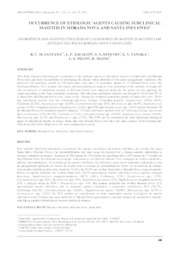Occurrence of etiologic agents causing subclinical mastitis in Morada Nova and Santa Ines ewes.
Occurrence of etiologic agents causing subclinical mastitis in Morada Nova and Santa Ines ewes.
Author(s): SANTANA, R. C. M.; ZAFALON, L. F.; ESTEVES, S. N.; TANAKA, E. V.; PILON, L. E.; MASSA, R.
Summary: This study aimed to determine the occurrence of the etiologic agents of subclinical mastitis in Santa Inês and Morada Nova ewes and their susceptibility to developing the disease when submitted to the same management conditions. We analyzed 250 mammary glands of 130 Santa Inês ewes and 143 mammary glands of 77 Morada Nova ewes. The California Mastitis Test, somatic cell counts and microbiological analysis were performed at the moment of drying off. The occurrences of subclinical mastitis in different breeds were analyzed using the chi-square test by adjusting the values according to the Yates continuity correction. The infectious subclinical mastitis was present in 33.1% and 35.1% of Santa Inês and Morada Nova ewes, respectively. Among the evaluated mammary glands of Santa Inês ewes, 20.4% had subclinical mastitis with the following infectious etiology: Coagulase-negative Staphylococci (CNS) (46%), Coliforms (22.0%), Streptococcus spp. (12.0%), Corynebacterium spp. (6%), Micrococcus spp. (6.0%), Staphylococcus aureus (2.0%), Coagulase-positive Staphylococci (2.0%) and CNS and Streptococcus spp. (4.0%) mixed infection. Of the Morada Nova ewe mammary glands evaluated, 21% had subclinical mastitis with the following etiologic agents and their occurrences: CNS (56.7%), Coliforms (13.3%), Corynebacterium spp. (10.0%), Staphylococcus aureus (10.0%), Micrococcus spp. (6.7%) and Streptococcus spp. (3.3%). The CNS can be considered the most important etiological agent of subclinical mastitis in sheep. Santa Inês and Morada Nova ewes have the same chances of developing sub-clinical mastitis when subjected to the same management system.
Publication year: 2013
Types of publication: Journal article
Keywords: Morada Nova, Santa Inês, Subclinical mastitis
Observation
Some of Embrapa's publications are published as ePub files. To read them, use or download one of the following free software options to your computer or mobile device. Android: Google Play Books; IOS: iBooks; Windows and Linux: Calibre.
Access other publications
Access the Agricultural Research Database (BDPA) to consult Embrapa's full library collection and records.
Visit Embrapa Bookstore to purchase books and other publications sold by Embrapa.

